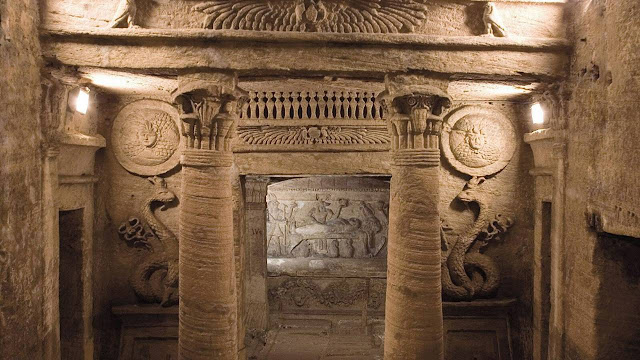The catacombs of Kom Kom El
Shoqafa actually a historical archaeological site located, just to the west of
Pompy's Pillar, Alexandria in Egypt. The meaning of catacombs of Kom Kom El
Shoqafa is “Mound of Shards” is considered one of the Seven Wonders of the
Middle Ages. Kom El Shuqafa, The “hill of treasures” in the Arabic language,
was unearthed by coincidence in the beginning of the 20th century. It is named,
because the area used to comprise of mounds of shards of terra cotta, mainly
resided of jars and objects made with clay. The objects were left by tombs
visitors who bring food and other stuff for their consumption during the visit.
When this area discovers, a heaps of broken plates founded, because they didn’t
want to carry such items home from this place of death so they would break
them. The city of Alexandria was originally established by Alexander the Great,
the most famous Greek King and army leader, in 332 BC and soon became the
cultural and commercial center of the Mediterranean Sea region.
The necropolis comprises of a
series of Alexandrian tombs, statues and archaeological objects of the
Pharaonic funeral cult with Hellenistic and early Imperial Roman influences. As
the time passes, several features of catacomsb of Kom El Shoqafa, merge Greek,
Roman and Egyptian cultural points. The Catacombs features includes a Hall of
Caracella, comprises of bones of young Christian men massacred by order of the
emperor Caracalla in 215 AD. The Hall of Caracella also contains the bones of
horses and humans were found A circular staircase, which was often used to
transport deceased bodies down the middle of it, leads down into the tombs that
were tunneled into the bedrock during the age of the Antonine emperors 2nd
century AD, used as a burial chamber, before being rediscovered in 1900 when a
donkey accidentally fell into the access shaft. So far, three sarcophagi have
been found, along with other human and animal remnants. It is believed that the
catacombs were only intended for a single family, but it is unclear why the
site was expanded in order to house numerous other individuals.
The western side of catacombs
comprises of three levels cut through solid rock, however, the third level
being now entirely underwater. The catacombs have a six-pillared central shaft
which opens off the vestibule. On the left is a triclinium, a funeral banquet
hall where friends and family gathered on stone couches covered with cushions,
both at the time of burial and also on future commemorative visits. Moreover, a
stone staircase descends to the second level, an area spookily alive with
sculptures. Further, in the building lobby, two pillars are topped by the
papyrus, lotus, and acanthus leaves of ancient Egypt and two falcons flanking a
winged sun adorn the frieze. Therefore, figures of a man and a woman are carved
into the wall. There’re 3 huge stone coffins with non-removable covers along
the sides of the chamber supposed that bodies were inserted in them from
behind, using a passageway which runs around the outside of the funeral
chamber. There is a hallway with 91" deep walls in the central tomb
chamber, with carved recesses, each providing burial space for three mummies.

 |








No comments:
Post a Comment